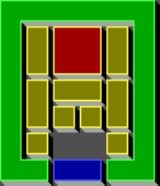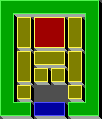
Klotski
Encyclopedia

Rules
Like other sliding-block puzzles, several different-sized block pieces are placed inside a box, which is generally in 4x5 size. Among the blocks, there is a special one (usually the largest) which must be moved to a special area designated by the game board. The player is not allowed to remove blocks; he may only slide blocks horizontally and vertically. Common goals are to solve the puzzle with a minimum number of moves or in a minimum amount of time.History
- Lewis W. Hardy obtained copyright for a game named Pennant Puzzle in 1909, manufactured by OK Novelty Co., Chicago. The aim of this puzzle is completely identical to Klotski, just default blocks and arrangement are different. He also filed on 1907-12-14, which is about a sliding-block puzzle similar to Pennant Puzzle, but with a slightly different combination of blocks and a different goal—not only the largest block must be moved to a specific location, but all of the other blocks must achieve a specific configuration as well. The patent was granted on 1912-02-20.
- John Harold Fleming obtained a patent in 1934 in EnglandEnglandEngland is a country that is part of the United Kingdom. It shares land borders with Scotland to the north and Wales to the west; the Irish Sea is to the north west, the Celtic Sea to the south west, with the North Sea to the east and the English Channel to the south separating it from continental...
(patent number 411515. He applied for it on 1932-12-07 and it was granted on 1934-06-07. The puzzle concerned has the same blocks and almost identical placement as forget-me-not, only that the unique horizontal 2x1 block is placed at the bottom instead of beneath the 2x2 block. The patent included a 79-step solution.
- It was known in FranceFranceThe French Republic , The French Republic , The French Republic , (commonly known as France , is a unitary semi-presidential republic in Western Europe with several overseas territories and islands located on other continents and in the Indian, Pacific, and Atlantic oceans. Metropolitan France...
as L'âne rouge (red donkey) at that time.
- It is said to trace back to a ThaiThailandThailand , officially the Kingdom of Thailand , formerly known as Siam , is a country located at the centre of the Indochina peninsula and Southeast Asia. It is bordered to the north by Burma and Laos, to the east by Laos and Cambodia, to the south by the Gulf of Thailand and Malaysia, and to the...
game called "Khun PhaenKhun Chang Khun PhaenKhun Chang Khun Phaen is an epic Thai poem which originated from a folktale and is one of the most notable works in Thai literature. Chang and Phaen are the leading male characters, and "Khun" was a junior feudal title given for male commoners. The story is a classic love triangle, ending in high...
Escapes to freedom".
- It is said that the game was already known in JapanJapanJapan is an island nation in East Asia. Located in the Pacific Ocean, it lies to the east of the Sea of Japan, China, North Korea, South Korea and Russia, stretching from the Sea of Okhotsk in the north to the East China Sea and Taiwan in the south...
around the 10th year of the Shōwa period, i.e. around 1935.
- One of the earliest books about standard Klotski was written by the Chinese professor 姜长英 on 1949,in his book 《科学消遣》. (translation: Science Pastime)
It is still unknown which one is the original, or (in turn) if it has evolved from some other sliding-block puzzle, say, the 15 puzzle
N-puzzle
The 15-puzzle is a sliding puzzle that consists of a frame of numbered square tiles in random order with one tile missing. The puzzle also exists in other sizes, particularly the smaller 8-puzzle...
, which enjoyed immense popularity in western countries during late 19th century. There are many confusing and conflicting claims, and several countries claim to be the ultimate origin of this game.
Solving
The minimum number of moves for the original puzzle is 81, which is verified by computer to be the absolute minimum for the default starting layout, if you consider sliding a piece two positions in the same direction to be a single move.The first published 81-step solution is by Martin Gardner
Martin Gardner
Martin Gardner was an American mathematics and science writer specializing in recreational mathematics, but with interests encompassing micromagic, stage magic, literature , philosophy, scientific skepticism, and religion...
, in Feb 1964 issue of Scientific American
Scientific American
Scientific American is a popular science magazine. It is notable for its long history of presenting science monthly to an educated but not necessarily scientific public, through its careful attention to the clarity of its text as well as the quality of its specially commissioned color graphics...
. In the article he discussed the following puzzles (with Edward Hordern
Edward Hordern
Lebbeus Edward A Hordern, known as Edward Hordern, was the world's leading authority on sliding block puzzles, and was renowned for his puzzle solving abilities....
classification code in parentheses): Pennant Puzzle (C19), L'Âne Rouge (C27d), Line Up the Quinties (C4), Ma's Puzzle (D1) and a form of Stotts' Baby Tiger Puzzle (F10).
For earliest published solutions (not optimal solution), currently known is from Chinese educator Xǔ Chún Fǎng (許蒓舫), in his book 《數學漫談》. (translation: Mathematics Tidbits; Hwa Yi Publication, March 1952) His solution involves 100 steps.
Variation
There are several variations of this game, some with names specific to the culture of certain countries, some with different arrangement of blocks.It is still unknown whether these variations affected each other and how.
Block name variation
The following variations basically have the same layout and block arrangement, varying only in name (human, animal, or others), usually with some sort of story behind the names. It is completely unknown whether they share the same origin, though this is highly possible as they are identical to each other.Hua Rong Dao
- Hua Rong Dao (alternatively named Hua Rong Path, Chinese name: 華容道) is the ChineseCulture of ChinaChinese culture is one of the world's oldest and most complex. The area in which the culture is dominant covers a large geographical region in eastern Asia with customs and traditions varying greatly between towns, cities and provinces...
variation, featuring an old legendary during Battle of Red CliffsBattle of Red CliffsThe Battle of Red Cliffs, otherwise known as the Battle of Chibi, was a decisive battle at the end of the Han Dynasty, immediately prior to the Three Kingdoms period of Chinese history. It was fought in the winter of 208/9 AD between the allied forces of the southern warlords Liu Bei and Sun Quan...
in the 13th year of Jian An in the East Han Dynasty 208208Year 208 was a leap year starting on Friday of the Julian calendar. At the time, it was known as the Year of the Consulship of Aurelius and Geta...
AD-- a well-known battleBattleGenerally, a battle is a conceptual component in the hierarchy of combat in warfare between two or more armed forces, or combatants. In a battle, each combatant will seek to defeat the others, with defeat determined by the conditions of a military campaign...
in Chinese history. The legendary: Cao CaoCao CaoCao Cao was a warlord and the penultimate chancellor of the Eastern Han Dynasty who rose to great power during the dynasty's final years. As one of the central figures of the Three Kingdoms period, he laid the foundations for what was to become the state of Cao Wei and was posthumously titled...
was defeated in this battle, and escaped to Hua Rong Dao, in which he encountered Guan YuGuan YuGuan Yu was a general serving under the warlord Liu Bei during the late Eastern Han Dynasty of China. He played a significant role in the civil war that led to the collapse of the Han Dynasty and the establishment of the state of Shu Han during the Three Kingdoms period, of which Liu Bei was the...
. Because Guan Yu remembered Cao Cao treated him well during old days despite he was a general of enemy of Cao Cao, Guan Yu spared Cao Cao's life. The largest block is named Cao Cao.
Daughter in the box

Yet another variation in Japan uses name of pieces from Shogi
Shogi
, also known as Japanese chess, is a two-player board game in the same family as Western chess, chaturanga, and Chinese Xiangqi, and is the most popular of a family of chess variants native to Japan...
.
L'âne rouge
In France it is well known as L'âne rouge. It features a red donkey (largest piece) trying to escape a maze of fences and pens to get to its carrots.Khun Chang Khun Phaen
This is the variation for Thailand. Description taken from University of Cambridge :- Khun Phaen is a famous character in Thai Legend. This game was originally known as `Khun Chang Khun PhaenKhun Chang Khun PhaenKhun Chang Khun Phaen is an epic Thai poem which originated from a folktale and is one of the most notable works in Thai literature. Chang and Phaen are the leading male characters, and "Khun" was a junior feudal title given for male commoners. The story is a classic love triangle, ending in high...
' and refers to Khun Phaen being imprisoned. He breaks out of jail by escaping the cordon of nine sentries who are guarding him.
There is a slight difference between Khun Chang Khun Phaen and the standard layout—the middle 2 1x1 blocks are moved to bottom. Other than that, all other blocks are the same. The origin of this variation is unknown in Thailand.
Block arrangement variation
In this context, the "basic" arrangement is assumed to be the one on top of this page, which is used globally as the "basic" game of Klotski. It is coded C27d in HordernEdward Hordern
Lebbeus Edward A Hordern, known as Edward Hordern, was the world's leading authority on sliding block puzzles, and was renowned for his puzzle solving abilities....
classification of sliding puzzle games.
Pennant Puzzle

- The default location of all blocks are different from Klotski. For example, the largest square block is in upper left corner.
- It is in 4x5 area, with one 2x2, two 1x2, four 2x1, two 1x1 pieces.
- The exit of block is not at the bottom middle, but bottom left.
Other than these, the game rule is completely the same as Klotski. The minimum number of moves to solve the puzzle is 59.
Ma's Puzzle
Ma's Puzzle is copyrighted by Standard Trailer Co. at 1927. It is the first sliding puzzle to use non-rectangular shape. Its goal is to join its 2 L-shaped pieces together, either anywhere or top right corner of the board.Computerized version
The first known graphical version of Klotski was created for WindowsMicrosoft Windows
Microsoft Windows is a series of operating systems produced by Microsoft.Microsoft introduced an operating environment named Windows on November 20, 1985 as an add-on to MS-DOS in response to the growing interest in graphical user interfaces . Microsoft Windows came to dominate the world's personal...
by ZH Computing in 1991. It was later in the same year included in the third Microsoft Windows Entertainment Pack.
Many versions of Klotski exist now, either freely available or commercially available. For example, one is included in the GNOME
GNOME
GNOME is a desktop environment and graphical user interface that runs on top of a computer operating system. It is composed entirely of free and open source software...
desktop environment. Some even include the idea of having blocks with special effects.
See also
- N-puzzleN-puzzleThe 15-puzzle is a sliding puzzle that consists of a frame of numbered square tiles in random order with one tile missing. The puzzle also exists in other sizes, particularly the smaller 8-puzzle...
- Rush Hour (board game)Rush Hour (board game)Rush Hour is a sliding block puzzle invented by Nob Yoshigahara in the late 1970s and first sold in the United States in 1996. It is manufactured by ThinkFun ....
- Mechanical puzzles
- Combination puzzlesCombination puzzlesA combination puzzle, also known as a sequential move puzzle, is a puzzle which consists of a set of pieces which can be manipulated into different combinations by a group of operations. The puzzle is solved by achieving a particular combination starting from a random combination...
External links
- easy-to-follow gif animation. Animation of the 'Forget-me-not' (L'Âne Rouge) solution.
- Solving Dad's Puzzle
- Solving Klotski puzzle
- Klotski by ZH Computing

